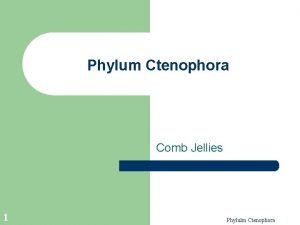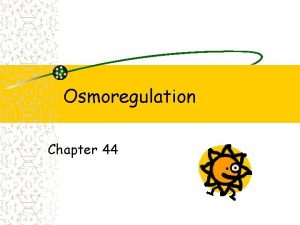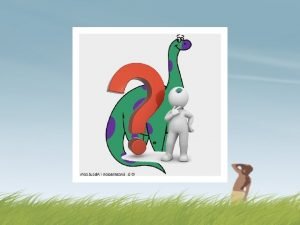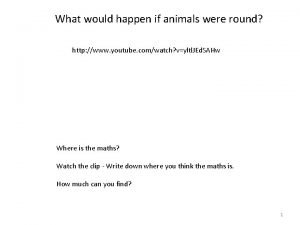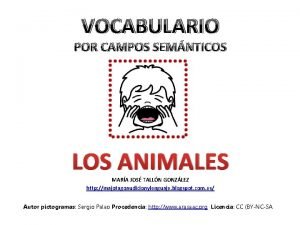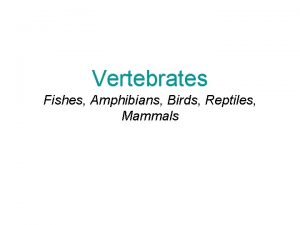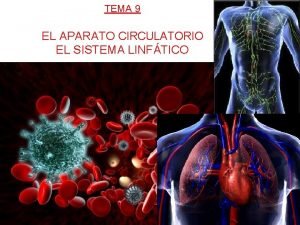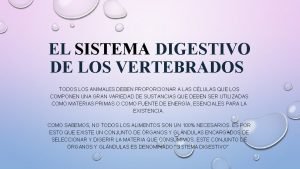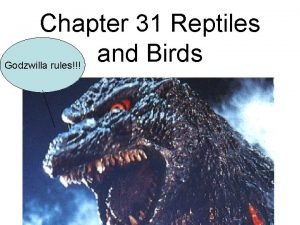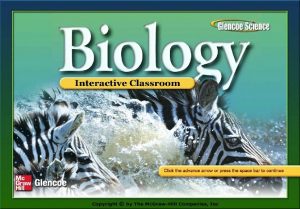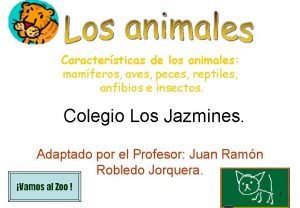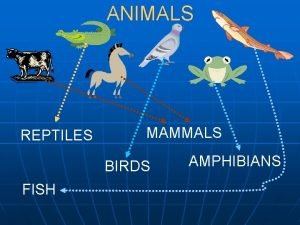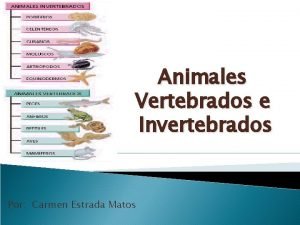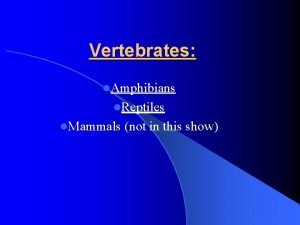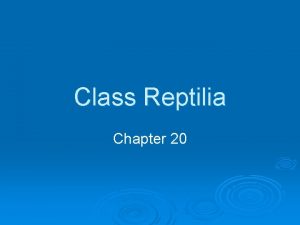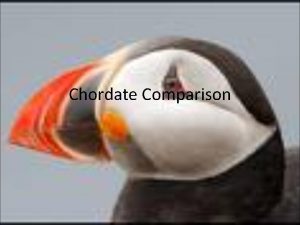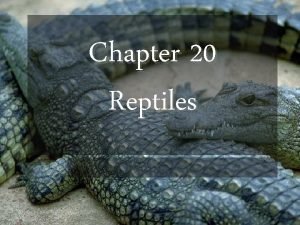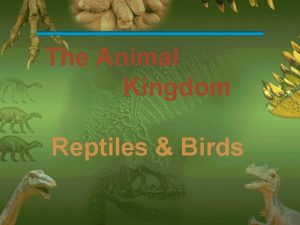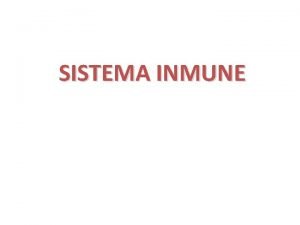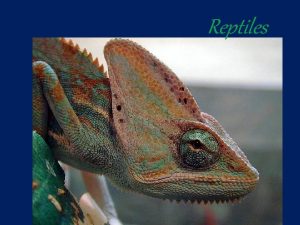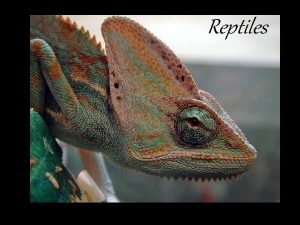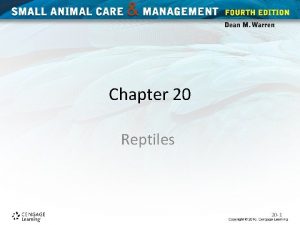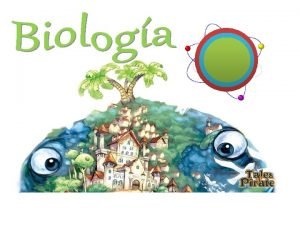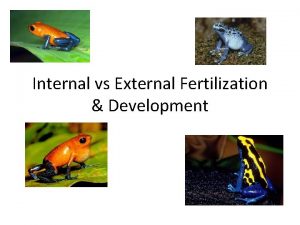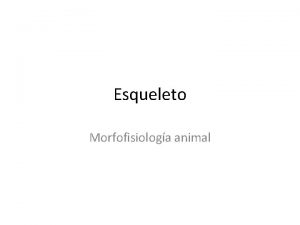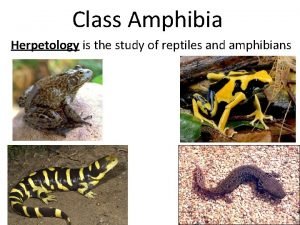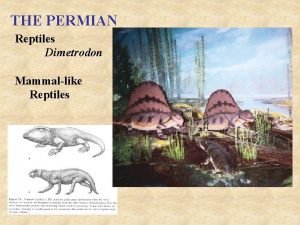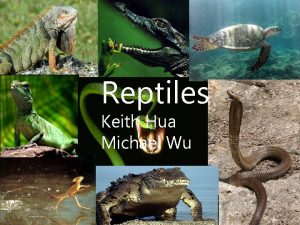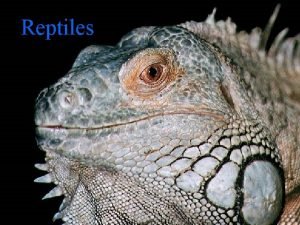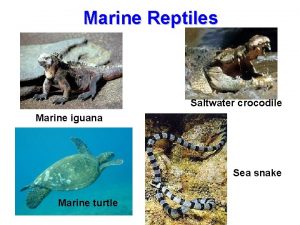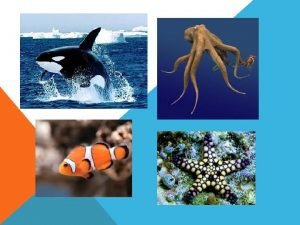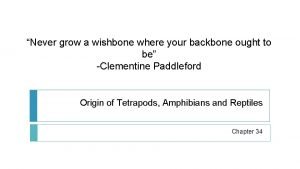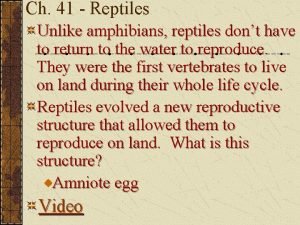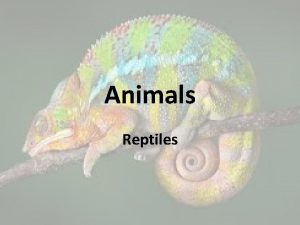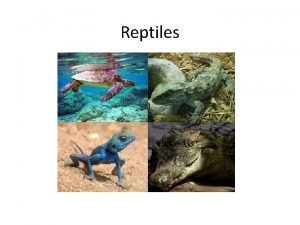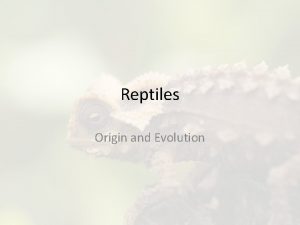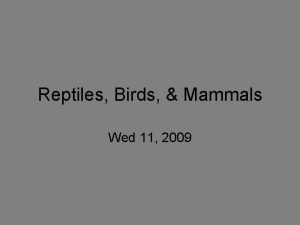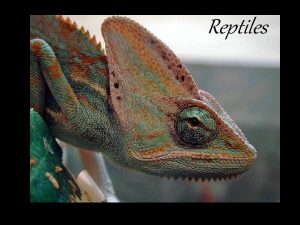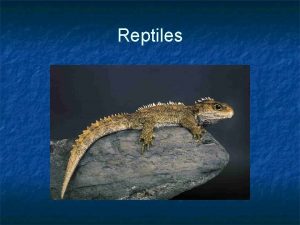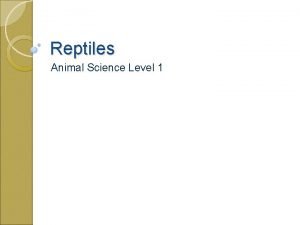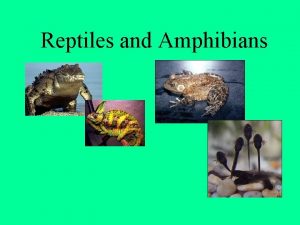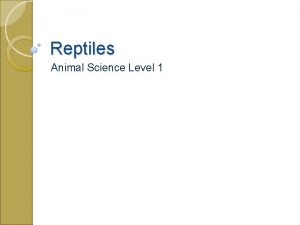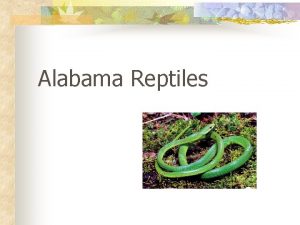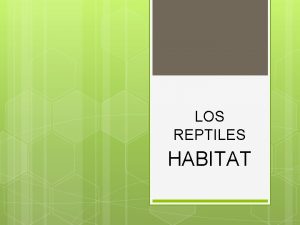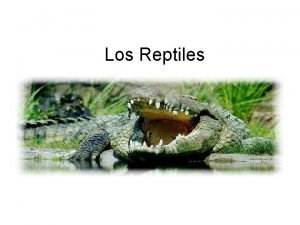1 Reptiles were the first animals to posses


















































































- Slides: 82

• 1. Reptiles were the first animals to posses an amniotic egg.

• 2. Amniotic eggs have membranes that protect the embryo from desiccation, cushion the embryo, help with gas exchange, and store waste material.

• 3. The amniotic eggs of reptiles and birds also have leathery or hard shells that protect the developing embryo, and a yolk that supplies food to them. • 4. All these are adaptations for development on land.

• 5. Reptiles are characterized by respiration with lungs, internal fertilization, dry skin with keratinized scales. • Keratin is a resistant protein.

• 6. There are four living reptiles; –Testudines are the turtles. –Squamata includes lizards, snakes, and worm lizards –Crocodilia include crocodiles, alligators, caimens, and gavials.

–Rhynchocephalia - tuataras

• 7. ORDER TESTUDINES Turtles There approximately 225 species of turtles. Characterized by a bony shell and a keratinized beak rather than teeth.

• 8. The dorsal(? ) portion of the shell is the carapace which forms from the fusion of ribs and bones in the dermis of the skin. • Keratin covers the bone of the carapace.

• 9. The ventral(? ) portion of the shell is the plastron. • Keratine also covers it.

• 10. Turtles have long life spans. Most reach sexual maturity after 7 or 6 years and live to be 14 or more years old. Large tortoises can live to be over 100 years old.

• 11. All turtles are oviparous. Females use their hindlimbs to dig nests in the soil. There they lay 5 to 100 eggs called a clutch and covers them with soil. • The young are independent of the parent.

• 12. ORDER RHYNCHOCEPHALIA • These are the tuataras. They look a lot like lizards but have a few differences. • Two rows of teeth on the upper jaw and a single row of teeth in the lower jaw.

• 13. They share underground burrows with ground nesting birds. • They leave the burrows at dusk and dawn to feed on insects and small vertebrates. • Live in New Zealand

• 14. ORDER SQUAMATA –Divided into 3 suborders Suborder Sauria (lizards) - About 3500 species of lizards.

• 15. Usually have two pairs of legs. • They usually deposit eggs under rocks or debris or in burrows.

• 16. Geckos *nocturnal with eyes adapted to night vision. *clicking vocalization. *Have adhesive discs on their toes that aid in clinging to objects.



• 17. Iguanas have heavy bodies, short necks, and distinctive heads. • Includes the marine iguanas of the Galapagos and the flying dragons of Southeast Asia.


• 18. Chameleons are adapted to arboreal lifestyles and use a long, sticky tongue to capture insects. • Best known for their ability to change color.


• 19. The only venomous lizards are the gila monster (Heloderma suspectum) and the Mexican beaded lizard (Heloderma horridum). They are native to Southwestern North America.



• 20. Venom is released into grooves on the surface of teeth and introduced into prey as the lizard chews. The bites are seldom fatal to humans.

• 21. Suborder Serpentes – Snakes –Most snakes are not dangerous to humans. Only about 300 of the 2300 species are poisonous.

• 22. Each year about 30, 000 to 40, 000 people die from snakebites, mostly in Southeast Asia. In the United States fewer than 100 people die each year from snakebites.

• 23. The skeleton may contain as many as 200 vertebrae and pairs of ribs. • Snakes possess skull adaptations that facilitate swallowing large prey.

• 24. These adaptations include upper jaws that are moveable on the skull and lower jaws that are loosely joined so that each half of the jaw can move independently.

• 25. Most snakes lay eggs although a few like boas and garter snakes give birth to live young.

• 26. Suborder Amphisbaenia (worm lizards) –They are specialized burrowers that live in Africa, South America, and the Caribbean. –Most have no legs.

• 26. A single tooth in the upper jaw distinguishes them from all other vertebrates. • They feed on worms and small insects.


• 27. ORDER CROCODILIA –Living members include alligators, crocodiles, caiman, and gavials. –The snout is elongated and used to capture food by a sideways sweep of the head.



• 28. The nostrils are at the tip of the snout so the animal can breathe while mostly submerged. • The muscular, elongate, tail is used for swimming and as an offensive and defensive weapon.

• 29. Teeth are used only for seizing prey. Food is swallowed whole but if it too big crocodilians tear it apart by holding onto a limb and rotating their bodies until it is dismembered.

• 30. The stomach is gizzardlike and they often swallow rocks and other objects as abrasives for breaking apart ingested food.

• 31. Crocodilians lay eggs and display parental care of hatchlings similar to that of birds.



• 32. External Structure and Locomotion of Reptiles –Unlike amphibians the skin of reptiles has no respiratory functions. –Reptilian skin is dry, thick, and keratinized.

• 33. Scales may be modified t for various functions. • All reptiles periodically shed the skin in a process called ecdysis.



• 34. Ecdysis generally begins in the head region and in snakes and many lizards the shed skin comes off in one piece. In other lizards smaller skin flakes off.

• 35. Nutrition and the Digestive System. – most reptiles are carnivorous although turtles will eat almost anything organic.

• 36. The tongues of turtles and crocodilians are nonprotrusible and aid in swallowing. • Some lizards have and tautara have sticky tongues for capturing prey. The tongue of a chameleon is longer than its body.


• 37. Snakes have elastic ligaments in their jaws and can swallow prey much larger than its head. • The glottis is a respiratory opening for breathing while it is swallowing its prey.


• 38. Vipers possess hollow fangs on the upper jaw. These fangs connect to venom glands that inject venom when the viper bites.

• 39. Venom glands are modified salivary glands. Most snake venoms are mixtures of neurotoxins and hemotoxins. • The venom of coral snakes, cobras, and sea snakes are primarily neurotoxins.

• 40. Neurotoxins attack nerve centers and cause respiratory paralysis. • The venom of vipers is primarily hemotoxin. They break up blood cells and attack blood vessel linings.



• 41. The circulatory system of reptiles is similar to that of amphibians.

• 42. Temperature Regulation –Temperature regulation is important for animals that spend their entire lives out of water. Most reptiles use external heat sources for thermoregulation and are called ectotherms.

• 43. To sustain activity body temperatures are regulated within a range between 25 and 37 C. • Most thermoregulation is behavioral and is best know in lizards.

• 44. In hot climates many reptiles are nocturnal. • Various physiological mechanisms also regulate temperature. Some pant to release heat by evaporative cooling. Little evaporation occurs across the skin. Some change color.

• 45. In cooler climates many withstand winter cold by entering torpor when body temperatures and metabolic rates decrease.

• 46. Individuals that are usually solitary may migrate to a common site called a hibernaculum to spend the winter. Unlike true hibernators the body of reptiles in torpor is not regulated.


• 47. If the winter is too cold the reptile can freeze and die.

48. Nervous and Sensory Functions Vision is the dominant sense in most reptiles, their eyes are similar to amphibians. Reptiles probably have well developed color vision.

• 49. Upper and lower eyelids fuse in snakes and some lizards to form a protective window of clear skin called a spectacle. This is what becomes cloudy when they shed.

• 50. Olfactory senses are better developed in reptiles than in amphibians. They have a Jacobson’s Organ which are used to detect odor molecules. Turtles do not have these.

• 51. A snake’s tongue flicks out and then moves to the Jacobson’s Organ. This helps them to determine the direction of their prey.


• 52. Rattlesnakes and pit vipers have heat-sensitive pit organs on each side of the face between the eye and nostril. They are used to detect objects with temperatures different from the snake’s surroundings.

• 53. Pit vipers are usually nocturnal and their pits help them to locate small, endothermic prey.




• 54. Reproduction and Development –The amniotic egg is not completely independent of water. Pores in the eggshell permit gas exchange but also allow water to evaporate.

• 55. These include head bobbing displays, revealing brightly colored patches of skin, tail waving. Vocalization is important in crocodilians. • Eggs are usually abandoned.

• 56. Temperature within the nest influences the sex of the hatchlings. Temperatures at or below 31. 5 degrees C result in female offspring. Temperature between 32. 5 and 33 C will result in males. Temps around 33 C result in both.



 Non periodic function fourier series
Non periodic function fourier series Ctenophora posses
Ctenophora posses Reptiles animals
Reptiles animals Dinosaurs were reptiles that lived during
Dinosaurs were reptiles that lived during Kyle douglass
Kyle douglass Animals that eat both plants and animals
Animals that eat both plants and animals Which energy
Which energy Animals that eat both plants and animals
Animals that eat both plants and animals If animals were round 2
If animals were round 2 Campo semántico de animales mamíferos
Campo semántico de animales mamíferos Chordate cladogram
Chordate cladogram Despolarizacion
Despolarizacion Plane filling motif with reptiles
Plane filling motif with reptiles Animales vertebrados mamiferos aves peces anfibios reptiles
Animales vertebrados mamiferos aves peces anfibios reptiles Caracteristicas de los moluscos
Caracteristicas de los moluscos Digestion de reptiles
Digestion de reptiles Chapter 31 reptiles and birds worksheet answer key
Chapter 31 reptiles and birds worksheet answer key Chapter 29 section 1 reptiles study guide answers
Chapter 29 section 1 reptiles study guide answers Chapter 29 section 1 reptiles
Chapter 29 section 1 reptiles Caracteristica de los reptiles
Caracteristica de los reptiles Amphibians reptiles mammals birds fish
Amphibians reptiles mammals birds fish Anfibios vertebrados o invertebrados
Anfibios vertebrados o invertebrados Different types of reptiles
Different types of reptiles Reptiles organs for locomotion
Reptiles organs for locomotion Filo porifera
Filo porifera Characteristics of reptilia
Characteristics of reptilia Reptiles organs for locomotion
Reptiles organs for locomotion Reptiles organs for locomotion
Reptiles organs for locomotion Reptiles order
Reptiles order Sistema inmune en reptiles
Sistema inmune en reptiles Phylum reptilia
Phylum reptilia Marbled crested lizard
Marbled crested lizard 3 characteristics of reptiles
3 characteristics of reptiles Mediante tecnicas bioquimicas un biologo celular determino
Mediante tecnicas bioquimicas un biologo celular determino Cuales son las aves
Cuales son las aves Fertilization and external in
Fertilization and external in El toyo
El toyo Amphibians and reptiles
Amphibians and reptiles Herpetology is the study of
Herpetology is the study of Transgression
Transgression Circulation in reptiles
Circulation in reptiles Fertilization in reptiles
Fertilization in reptiles Freshwater lizards
Freshwater lizards Are dolphins carnivores herbivores or omnivores
Are dolphins carnivores herbivores or omnivores Do reptiles show up on thermal imaging
Do reptiles show up on thermal imaging Anapsid vs diapsid
Anapsid vs diapsid Unlike amphibians reptiles
Unlike amphibians reptiles Was/were going to
Was/were going to Hình ảnh bộ gõ cơ thể búng tay
Hình ảnh bộ gõ cơ thể búng tay Ng-html
Ng-html Bổ thể
Bổ thể Tỉ lệ cơ thể trẻ em
Tỉ lệ cơ thể trẻ em Voi kéo gỗ như thế nào
Voi kéo gỗ như thế nào Tư thế worms-breton
Tư thế worms-breton Chúa yêu trần thế
Chúa yêu trần thế Kể tên các môn thể thao
Kể tên các môn thể thao Thế nào là hệ số cao nhất
Thế nào là hệ số cao nhất Các châu lục và đại dương trên thế giới
Các châu lục và đại dương trên thế giới Công thức tính độ biến thiên đông lượng
Công thức tính độ biến thiên đông lượng Trời xanh đây là của chúng ta thể thơ
Trời xanh đây là của chúng ta thể thơ Mật thư anh em như thể tay chân
Mật thư anh em như thể tay chân Phép trừ bù
Phép trừ bù Phản ứng thế ankan
Phản ứng thế ankan Các châu lục và đại dương trên thế giới
Các châu lục và đại dương trên thế giới Thể thơ truyền thống
Thể thơ truyền thống Quá trình desamine hóa có thể tạo ra
Quá trình desamine hóa có thể tạo ra Một số thể thơ truyền thống
Một số thể thơ truyền thống Cái miệng bé xinh thế chỉ nói điều hay thôi
Cái miệng bé xinh thế chỉ nói điều hay thôi Vẽ hình chiếu vuông góc của vật thể sau
Vẽ hình chiếu vuông góc của vật thể sau Nguyên nhân của sự mỏi cơ sinh 8
Nguyên nhân của sự mỏi cơ sinh 8 đặc điểm cơ thể của người tối cổ
đặc điểm cơ thể của người tối cổ V cc
V cc Vẽ hình chiếu đứng bằng cạnh của vật thể
Vẽ hình chiếu đứng bằng cạnh của vật thể Fecboak
Fecboak Thẻ vin
Thẻ vin đại từ thay thế
đại từ thay thế điện thế nghỉ
điện thế nghỉ Tư thế ngồi viết
Tư thế ngồi viết Diễn thế sinh thái là
Diễn thế sinh thái là Dot
Dot Số nguyên tố là
Số nguyên tố là Tư thế ngồi viết
Tư thế ngồi viết Lời thề hippocrates
Lời thề hippocrates

